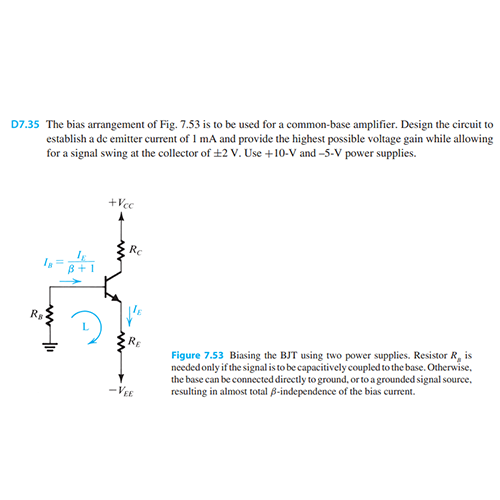D7.35 The bias arrangement of Fig. 7.53 is to be used for a common-base amplifier. Design the circuit to establish a de emitter current of 1 mA and provide the highest possible voltage gain while allowing for a signal swing at the collector of ±2 V. Use +10-V and -5-V power supplies.
D7.35 The bias arrangement of Fig. 7.53 is to be used for a common-base amplifier. Design the circuit to establish a de emitter current of 1 mA and provide the highest possible voltage gain while allowing for a signal swing at the collector of ±2 V. Use +10-V and -5-V power supplies.
Introductory Circuit Analysis (13th Edition)
13th Edition
ISBN:9780133923605
Author:Robert L. Boylestad
Publisher:Robert L. Boylestad
Chapter1: Introduction
Section: Chapter Questions
Problem 1P: Visit your local library (at school or home) and describe the extent to which it provides literature...
Related questions
Question
100%

Transcribed Image Text:D7.35 The bias arrangement of Fig. 7.53 is to be used for a common-base amplifier. Design the circuit to
establish a de emitter current of 1 mA and provide the highest possible voltage gain while allowing
for a signal swing at the collector of ±2 V. Use +10-V and -5-V power supplies.
R₂4
+Vcc
RE
-VEE
Figure 7.53 Biasing the BJT using two power supplies. Resistor R is
needed only if the signal is to be capacitively coupled to the base. Otherwise,
the base can be connected directly to ground, or to a grounded signal source,
resulting in almost total 8-independence of the bias current.
Expert Solution
This question has been solved!
Explore an expertly crafted, step-by-step solution for a thorough understanding of key concepts.
This is a popular solution!
Trending now
This is a popular solution!
Step by step
Solved in 2 steps with 1 images

Follow-up Questions
Read through expert solutions to related follow-up questions below.
Knowledge Booster
Learn more about
Need a deep-dive on the concept behind this application? Look no further. Learn more about this topic, electrical-engineering and related others by exploring similar questions and additional content below.Recommended textbooks for you

Introductory Circuit Analysis (13th Edition)
Electrical Engineering
ISBN:
9780133923605
Author:
Robert L. Boylestad
Publisher:
PEARSON

Delmar's Standard Textbook Of Electricity
Electrical Engineering
ISBN:
9781337900348
Author:
Stephen L. Herman
Publisher:
Cengage Learning

Programmable Logic Controllers
Electrical Engineering
ISBN:
9780073373843
Author:
Frank D. Petruzella
Publisher:
McGraw-Hill Education

Introductory Circuit Analysis (13th Edition)
Electrical Engineering
ISBN:
9780133923605
Author:
Robert L. Boylestad
Publisher:
PEARSON

Delmar's Standard Textbook Of Electricity
Electrical Engineering
ISBN:
9781337900348
Author:
Stephen L. Herman
Publisher:
Cengage Learning

Programmable Logic Controllers
Electrical Engineering
ISBN:
9780073373843
Author:
Frank D. Petruzella
Publisher:
McGraw-Hill Education

Fundamentals of Electric Circuits
Electrical Engineering
ISBN:
9780078028229
Author:
Charles K Alexander, Matthew Sadiku
Publisher:
McGraw-Hill Education

Electric Circuits. (11th Edition)
Electrical Engineering
ISBN:
9780134746968
Author:
James W. Nilsson, Susan Riedel
Publisher:
PEARSON

Engineering Electromagnetics
Electrical Engineering
ISBN:
9780078028151
Author:
Hayt, William H. (william Hart), Jr, BUCK, John A.
Publisher:
Mcgraw-hill Education,